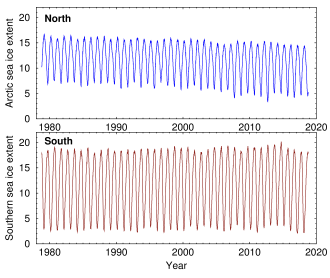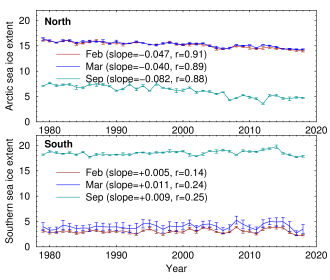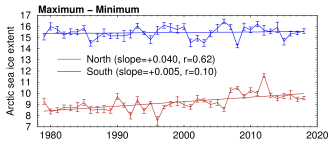 lobal warming may no longer be interesting to most people, but that's not stopping
weird stuff from happening at the poles. Superficially, the Arctic ice cap seems to
be shrinking, while the amount of Antarctic sea ice is constant. But the details
seem to be inconsistent with the theory of anthropogenic global warming.
lobal warming may no longer be interesting to most people, but that's not stopping
weird stuff from happening at the poles. Superficially, the Arctic ice cap seems to
be shrinking, while the amount of Antarctic sea ice is constant. But the details
seem to be inconsistent with the theory of anthropogenic global warming.

Fig. 1 Sea ice extent 1979–present. Data source: National Snow and Ice Data Center, https://nsidc.org/data/seaice_index,

Fig. 2 Arctic and Southern sea ice extent, mean ± SD for February, March, and September

Fig. 3 Sea ice, summer minus winter extent
Fig. 1 shows the daily sea ice extent in the Arctic and in the Southern Ocean. In the Arctic, the ice extent is decreasing twice as fast in September (the month when there's the least ice), as in March, when the ice is maximal (Fig. 2). Assuming the September decrease continues linearly over time (which is the only way of estimating it without assuming a mechanism), the Arctic Ocean will be ice-free in the summer 93.67 years from the starting point of the data set (January 1, 1979*), sometime in 2072.
Of course, that last sentence is packed with assumptions. No one can say for sure whether the trend will continue or whether it's part of some new, poorly-understood phenomenon. There's a lot we don't understand about climate.
To see this, note that the sea ice in the Southern hemisphere shows a slight increasing trend, though it is not (yet) statistically significant. Assuming it is real, and assuming it continues, at its current rate it will cover the surface of the globe some time in the year 7,694. Claims made by some glossy magazines that the Antarctic ice is disappearing are false.
If AGW were causing these changes, ice should be decreasing at the same rate in both hemispheres, and it should decrease faster in the winter, because the CO2 theory predicts preferential moderation of colder regions.
Some climate activists have predicted that the Arctic will be ice-free as early as 2020. However, these analyses are based on the assumption that the mechanism for the loss of ice is global warming. Their predictions are based on assuming the thing they are trying to prove, so they are invalid. Models tell us what to expect if it's working the way we think. What we can't say is that it's working the way we think because the model predicts it.
So what might be happening? Note that the summer ice in the Southern Ocean is already below 3×106 km2. The most likely cause for the low amount of ice is the strong subsurface current in the Southern Ocean, which exposes the ice to warmer water, melting it earlier in the season than in the Arctic. This explains why the lowest ice extent in the south occurs in February, a month earlier than would be expected, while the lowest extent in the Arctic is in September, not August. The Arctic ice is relatively isolated since the Arctic Ocean is surrounded by continents.
Therefore, assuming these numbers are not just random fluctuations, the Arctic sea ice seems to be starting to behave more like the Southern sea ice, with a greater difference between summer and winter extent. The lower curve in Fig. 3 shows that there is a statistically significant trend in this direction in the north (r = 0.623, p=1.74×10−5), but not in the south.
Unexplained phenomena make science interesting. Unwillingness to jump to conclusions keeps it from becoming a religion.
* The dataset actually starts in October 26, 1978. Since this misses the September ice minimum, the last three months of 1978 are usually dropped.
oct 14 2018, 4:18 am; edited oct 15 2018, 6:43 am
